How to Easily Fix Firefox High CPU Usage Issues
Sometimes when checking Task Manager, you may notice that the Firefox browser is using too much memory or CPU resources. This is because browsers may sometimes require more system resources to download content from the web, process it and then present it to the user. This also happens when you have too many tabs open in the Firefox browser when you want to multitask, for example, checking emails while working or playing games and listening to music, etc.
It could also be that you are loading heavy website content or there are processes running in the background. While Firefox is known for super-safe browsing and many advanced features like customization options or tab management, the fact that it consumes a lot of PC resources can ultimately slow down your PC's performance. The more you use your browser, the more available memory (RAM) it consumes, and the worst part is, this isn't a one-time situation.
Luckily, there are several ways to help you free up RAM and CPU space and ensure your PC runs well while you're using your browser. Here, we've listed some troubleshooting options that can help you resolve issues when Firefox uses too much memory or CPU resources.
Method 1: Update to the latest version
Sometimes, updating your browser to the latest version can help get rid of high CPU usage issues. Let’s see how to update Firefox to the latest version:
Step 1: Launch the Firefox browser and navigate to the upper right corner of the window.
Click on the three parallel lines (to open the application menu), then click on Settings.
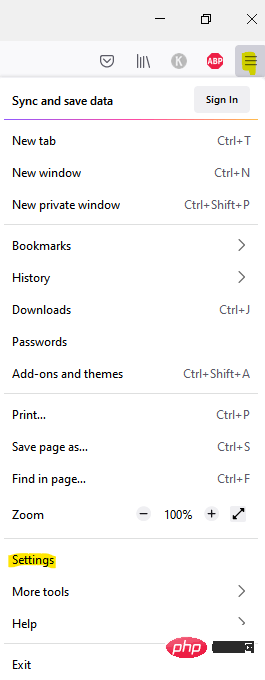
Step 2: In the Settings window, make sure you are on the General page.
Now, go to the right, scroll down and under the Firefox Updates section, click Check for updates.

Wait for it to finish checking for updates. If there are any updates available, it will automatically install the latest version and display a success message.
Now, restart the browser and you can now check if the CPU usage is still high.
Method 2: Restart Firefox
Restarting Firefox regularly can sometimes help solve many problems, including high browser memory or CPU usage. In fact, you can set up Firefox in a way so that the next time you launch the browser, you can pick up where you left off with your saved tabs and windows. This is one of the ways to restart Firefox browser. Let’s see how:
Restart Firefox by restoring previous session
Step 1:Open Firefox and go to the upper right corner.
Click on the three horizontal lines and select History from the menu
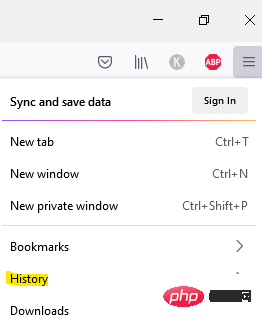
Now, click on Restore the previous session.
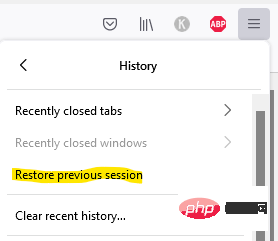
While this will take you back to the tabs and windows you were working on previously, you can also restart Firefox after the update while you are in Troubleshooting Mode/Safe When you restart Firefox in Windows mode, or when you resume a session by clicking the Resume Session button in the prompt that appears after a Firefox crash.
Restart Firefox via Task Manager
Step 1: Go to Start and right-click on it.
SelectTask Manager from the menu.
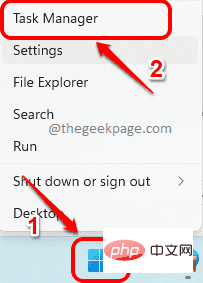
Step 2: In the Task Manager window, under the Processes tab, go to tabpart.
Now, right-click on Firefox and select End task.
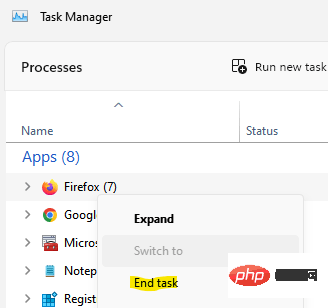
After Firefox closes, you can close Task Manager and open Firefox again.
Method 2: Disable resource-consuming extensions and themes
Before proceeding to disable any extensions or themes in the Firefox browser, make sure to first check if the issue is caused by extensions and themes . To do this, you need to launch your browser in safe mode. That's it:
Step one: Open Firefox and enter the three parallel lines in the upper right corner.
Click on it and select Help from the menu.

Now, select Troubleshooting mode.

Step 2: Next, restart Firefox in troubleshooting mode? Tip, click Restart.

Step 3: You will now see a prompt - Open Firefox in Troubleshooting Mode?
Click to open .
Step 4: This will restart the Firefox browser in Troubleshooting Mode/Safe Mode and disable extensions and themes.
Now, if the CPU or memory usage issue is resolved, then the problem is indeed caused by the extension and theme. Therefore, you must disable them immediately. That's it:
*Note - However, if memory and CPU usage are still high, then the problem is not due to extensions and themes.
Disable Firefox extensions and themes
Step 1: Open Firefox and click the Open Application menu (three parallel lines) in the upper right corner of the browser.
Select Settings from the menu.
Step 2: In the Settings window, at the bottom on the left side of the pane, click the Extensions and Themes option.
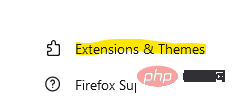
Step 3: The Add-in Manager window will now open in a new tab.
Here, click Extensions on the left.
Step 4: Now, navigate to the right and under the “Manage Extensions” section, go to Add-ons.
To disable the plugin, simply slide the toggle to the left.
Step 5: Repeat this for all add-ons.

Now, close the Settings window, restart the browser, and now your Firefox should not be using up too many system resources.
Disable Firefox Theme
Step 1: Launch the Mozilla Firefox browser, go to the three parallel lines in the upper right corner, click on it and select Settings.
Step 2: In the Settings window, go to the bottom left of the window and click Extensions and Themes.
Step 3: Next, go to the right side and under the “Enabled” section, click on the “Enable” button to disable the theme.
This will automatically apply the default theme and should resolve high CPU and memory usage issues.
Method Three: Block Intrusive Content
Using this method, you can block web content that uses your system resources and you don’t want to see. To do this, you can adjust the Enhanced Tracking Protection feature to help save resources by blocking 3rd party tracker intrusions. Let's see how to adjust the functionality:
Step one: Open Firefox, click on the open application menu (three horizontal lines) in the upper right corner, and select Settings.
Step 2: In the Settings window, click Privacy & Security on the left side of the pane.
Step 3: Now, go to the right side and under the Enhanced Tracking Protection section, select Protection Level - Standard (Balanced Protection and Performance.
to , Strict (Stronger Protection) or Custom (allows you to choose which trackers and scripts to block.)

Now that you have blocked 3rd party tracking content, the browser should not use high system resources.
Method Four: Disable Firefox Hardware Acceleration
Step 1: Launch Mozilla Firefox, go to the upper right corner of the browser, and click the three parallel lines.
SelectSettings from the menu.
Step 2: In the Settings window, stay on "General" page.
Now, go to the right and keep scrolling until you reach the "Performance" section.
Step 3: Uncheck Use recommended performance Set the box next to .
Step 4: Next, also uncheck the "Use hardware acceleration when available" option.

The issue with Firefox using too much memory or CPU resources should now be fixed.
*Note – You can also adjust the Content Process Limit field. When using a large number of options at once Choosing a higher number will improve browser performance when stuck and using system memory. If memory issues arise, such as in this case, you can lower the limit below 8.
Method Five: Remove content-prefs.sqlite file
Mozilla Firefox stores individual website settings in a file in your user profile folder. This file that holds the data can become corrupted and cause high memory and CPU usage issues . Therefore, deleting or renaming this file can help solve CPU usage issues. Let’s see how:
Step 1: Open Firefox, navigate to the three horizontal lines in the upper right corner, and click to open the menu.
In the menu, select Help.

Now, click More Troubleshooting Information.

Step 2: It will open the Troubleshooting Information tab in the browser.
Here, go to the Application Basics section and under Profile Folder and click the Open Folder button next to it.

3rd Step: This will open your profile folder in a File Explorer window.
Here, look for the content-prefs.sqlite file, select it and click Delete.
Now, Restart Firefox Browser

*Note –Next time you launch Firefox Browser , a new content-prefs.sqlite file will be created again.
Now, Firefox’s high memory and CPU usage issues should be resolved.
Method 6: Refresh Firefox
By refreshing the browser, your Firefox profile will be restored to its original state, which can help solve the problem. Let's see how to refresh Firefox:
Step 1: Open Mozilla Firefox, go to the three parallel lines in the upper right corner, click on it and select Help from the menu.

Step 2: Next, click on the More Troubleshooting Information option.

Step 3: In the Troubleshooting Information tab that opens, go to the right and under Tweak Firefox, click Refresh Firefox".

More Tools in the menu

Task Manager .


about:memory in the address bar and press Enter.
Step 2: You will now see a list of options. Click the "Minimize memory usage" button below the "Available Memory" option.

About: Configuration
Step 2: In the next window, under the "Caution Caution" warning, click the "Accept the Risk and Continue" button to continue. Step 3: Next, in the Search Preferences Name search bar, type the following address:browser.sessionhistory.max_entries
You You will now see the results below. Click thepencil icon to its right to edit the field.
Change the number to a smaller number and press the blue tick to the right of it to save the changes.
While restarting your PC is the first trick you can try and works in most cases, you can also choose to use fewer tabs and reduce the load on system memory usage.
Another wise move is to close many open applications to see if this helps reduce memory and CPU usage. Alternatively, you can also check how your system resources are performing under the Performance tab of the Task Manager window.
Despite all the above solutions, if your system is still low on memory, adding new RAM can help improve system performance. However, if nothing works, upgrading your computer may be the only option.
The above is the detailed content of How to Easily Fix Firefox High CPU Usage Issues. For more information, please follow other related articles on the PHP Chinese website!

Hot AI Tools

Undresser.AI Undress
AI-powered app for creating realistic nude photos

AI Clothes Remover
Online AI tool for removing clothes from photos.

Undress AI Tool
Undress images for free

Clothoff.io
AI clothes remover

AI Hentai Generator
Generate AI Hentai for free.

Hot Article

Hot Tools

Notepad++7.3.1
Easy-to-use and free code editor

SublimeText3 Chinese version
Chinese version, very easy to use

Zend Studio 13.0.1
Powerful PHP integrated development environment

Dreamweaver CS6
Visual web development tools

SublimeText3 Mac version
God-level code editing software (SublimeText3)

Hot Topics
 1378
1378
 52
52
 How to add trusted sites in Firefox? -How to add trusted sites to Firefox
Mar 27, 2024 pm 10:00 PM
How to add trusted sites in Firefox? -How to add trusted sites to Firefox
Mar 27, 2024 pm 10:00 PM
1. The user double-clicks on the computer desktop to open the Firefox browser software, and enters the home page to click the three horizontal icons in the upper right corner. 2. In the drop-down tab that pops up, the user selects the setting option and enters the setting window. 3. In the settings window that opens, the user needs to switch the tab on the left to the Privacy and Security tab. 4. Then the relevant function options will be displayed on the right side of the page. The user can directly enter the permissions section. Click the exception button of the block pop-up window option 5. In the pop-up website window with page special permissions, the user enters the URL in the website address box and presses the Allow and Save Changes buttons in sequence to set up website trust.
 How to change the language in Firefox
Jun 22, 2024 am 01:31 AM
How to change the language in Firefox
Jun 22, 2024 am 01:31 AM
How to change the language in Firefox? Firefox is a pure and easy-to-use open source browser software. This browser brings users a fast and pure Internet experience. The default language of the Google Chrome we downloaded and installed is Chinese. This browser supports multiple Many friends need to change the interface language to another country's language, so how to operate it at this time. This article brings you an overview of how to change the language of the Firefox browser interface. Friends in need should not miss it. Overview of how to change the language of the Firefox browser interface 1. The user opens the Firefox browser on the computer, and goes to the homepage and clicks the three horizontal icons in the upper right corner, and then a drop-down tab pops up, and the user selects the setting option (as shown in the figure). 2. The page switches and enters the settings window.
 Why can't I access gate.io?
Apr 24, 2024 pm 02:25 PM
Why can't I access gate.io?
Apr 24, 2024 pm 02:25 PM
Reasons for gate.io being inaccessible include regional restrictions, maintenance or upgrades, network issues, browser compatibility, anti-fraud measures, and DNS resolution issues. Solution: Confirm that there are no regional restrictions, wait for maintenance to be completed, check the network connection, update the browser, contact customer service to unblock, and adjust DNS settings.
 What's the matter with Railway 12306 not working?
Apr 30, 2024 am 11:42 AM
What's the matter with Railway 12306 not working?
Apr 30, 2024 am 11:42 AM
Reasons for 12306 being unavailable include website maintenance, network problems, browser problems, system failures, busy servers and plug-in interference. Solutions include: checking maintenance time, checking network connection, changing browsers, waiting for system repair, and disabling browser plug-ins.
 How to change the default download path in Firefox How to change the default download path in Firefox
May 09, 2024 am 11:19 AM
How to change the default download path in Firefox How to change the default download path in Firefox
May 09, 2024 am 11:19 AM
1. Open the Firefox browser, click the [three horizontal lines] icon in the upper right corner, and select [Settings] in the drop-down menu bar, as shown in the figure below. 2. Select [General] on the settings page, scroll down the page, and find [Files and Applications], as shown in the figure below. 3. Under the download options bar, click [Browse] after the save file option box, as shown in the figure below. 4. In the pop-up dialog box, select the download directory location you want to change, as shown in the figure below. 5. After the selection is completed, select "Always ask you where to save files" so that you can change the default download path and select it each time you download a file, as shown in the figure below.
 How to enable remote debugging in Firefox
Apr 15, 2024 pm 06:04 PM
How to enable remote debugging in Firefox
Apr 15, 2024 pm 06:04 PM
How to enable remote debugging in Firefox? Firefox is an open source web browsing tool. This browser supports multiple operating systems and has very powerful functions. The remote debugging function can support users to modify page code settings. Many users are not interested in this function. It's not clear, so many people don't know where the remote debugging function is turned on. Next, the editor will introduce to you the steps to enable remote debugging in Firefox browser. Friends who are interested must not miss it. Introduction to the steps to enable remote debugging in Firefox 1. The user opens the Firefox browser software on the computer, and goes to the home page and clicks on the three horizontal icons in the upper right corner (as shown in the picture). 2. Then in the drop-down tab that pops up, the user selects more tool options (
 How to view the source code of a page in Firefox How to view the source code of a page in Firefox
May 09, 2024 pm 02:10 PM
How to view the source code of a page in Firefox How to view the source code of a page in Firefox
May 09, 2024 pm 02:10 PM
1. First open the Firefox browser and click the [three horizontal lines] icon in the upper right corner, as shown in the figure below. 2. Then click [More Tools] in the menu bar that opens, as shown in the figure below. 3. Finally, on the More Tools page, click [Page Source Code] to view the page file source code, as shown in the figure below.
 How to check the version number in Firefox How to check the version number in Firefox
May 09, 2024 pm 12:04 PM
How to check the version number in Firefox How to check the version number in Firefox
May 09, 2024 pm 12:04 PM
1. Open the Firefox browser (as shown in the picture). 2. Click the left mouse button on the icon as shown in the picture (as shown in the picture). 3. Click [Settings] with the left mouse button (as shown in the picture). 4. The page slides down (as shown in the picture). 5. Find the [Firefox Update] section and you can see the version number of Firefox (as shown in the picture).



